|
What is
the analemma and how does it work?
An elongated figure 8 has been carved into the faces of the two
central stones. This line reflects the path that the sun's image
sweeps out a mid-day over the course of the year. The image is
projected through a small hole set in a brass plate under the lintel
of the south trilithon.
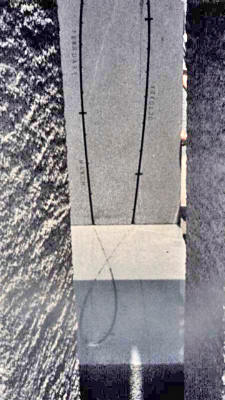
Figure 18. The
scribed analemma on the face of the two central Stonehenge blocks.
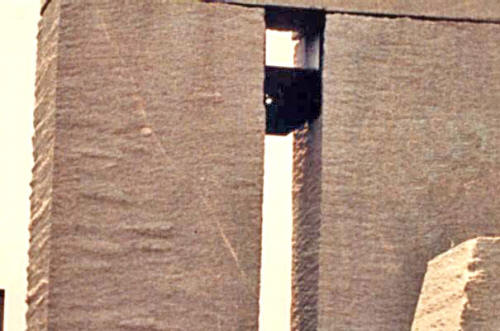
Figure 19. Focusing aperture plate on the South Trilithon.
Just before mid-day the sun shines
through this hole and the resulting image strikes the central rocks.
At midday precisely, it is centered on the scribed line.
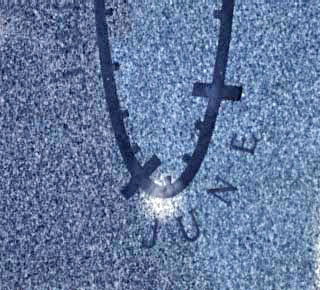
Figure 20. Sun's
image as it crosses the analemma curve at midsummer.
By marking the position of the sun on
the line, which is notched for every fifth day, it is possible to
read what day of the year it is.
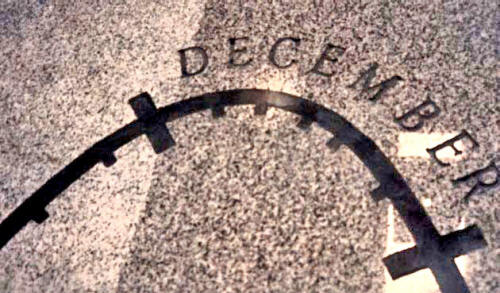
Figure 21. Analemma
marks for each five day period, with the sun crossing the curve at
midwinter.
Back to Top
Who thought of
this idea?
This device was used by the Anasazi Indians in Chaco Canyon in New
Mexico in the hey day of that culture. The Indians built a number of
pueblos in the canyon, in the period from 950 to 1100 A.D. Because
they had to know when to plant their crops they developed a form of
calendar using the position of the sun. The annual movement of the
sun around the sky, and other astronomic ideas, grew to have both a
practical and a religious role both then, and, in modern times, in
Hopi and Zuni culture.
At Pueblo Bonito the Anasazi used windows to limit the entry of the
sun into certain rooms to only known times. Thus, for example, the
sun would first enter one room about seven weeks before the winter
solstice, and the beam would move about three centimeters a day.
This would allow the Sun Priests time to predict the actual
solstice.
Perhaps the more famous set of solar markers at Chaco Canyon is,
however, the two spirals carved into a rock face at Fajada Butte.
These spirals, which are less than half a meter wide, are carved
behind three rock slabs, which appear to have naturally fallen into
place. At the summer solstice a shaft of light, formed by the slabs,
appears above the larger spiral at about 11 am. Over the next twenty
minutes, it is reported by Zeilick, that the shaft of light will
sink down through the heart of the spiral. At the winter solstice
the light appears, instead, at the edge of the spiral. In this
manner two of the important calendar days of the year can be
identified.
Although this is useful, and may have a significant religious
aspect, it is, not enough to provide an accurate calendar for the
planting of crops, and other needs of the tribe. For this reason the
other predictors, where the sun beams entered certain windows, and
struck certain features within the buildings on given days within
the year are more likely to have been of daily use. It is this
feature, of light access to different points on different days,
which Dr Senne adopted to this UMR calendar.
Back to Top
What else does
the UMR-Stonehenge do?
At dawn on mid-summer morning the sun rises, as viewed from the
center of the henge, over the heelstone - although this is currently
hidden by St. Pat's Church. It sets that night through the northwest trilithon gap.
The sunrise occurs at around 6 am
although the sun is not clearly seen for several minutes until it
clears the trees that are currently covering the horizon.
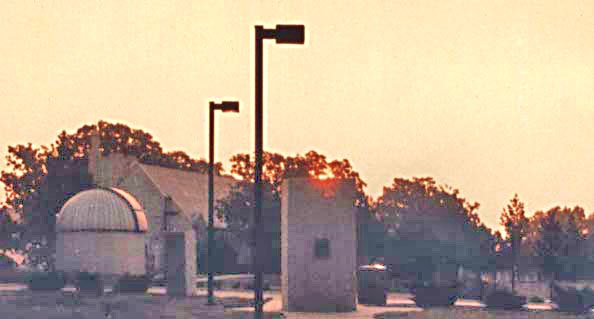
Figure 22. Midsummer
sunrise over the heel stone.
That evening the sun set can be viewed
from the center of the Stonehenge, with the sun setting through the
legs of the Northwest Trilithon.
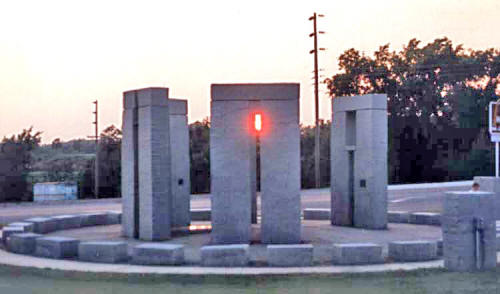
Figure 23. Sunset
behind the Northwest Trilithon, Midsummer's Eve.
On mid-winters morning, the sun rising
can be viewed through the SouthEast Trilithon, and it's setting
through the SouthWest Trilithon.
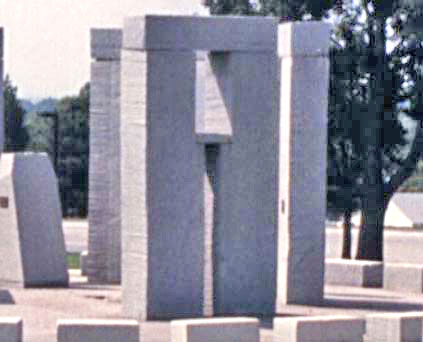
Figure 24. Polar
window in the North Trilithon.
The box opening of the North Trilithon
frames the position of the North Star when viewed, at night, from
half-way between the center of the circle and the stone. This
position is marked with two lights inset into the asphalt floor of
the monument. The accuracy of this positioning has been calculated
for the next 4,000 years.
Back to Top
When was it
built?
The UMR-Stonehenge project began in 1982, when Dr. Marchello formed
the organizing committee. The rock was acquired in 1983, and rock
cutting started in the fall of that year. It was completed during
1984 and dedicated on the evening of June 20, 1984, the shortest
night of the year, in the presence of John Bevan, white-robed Druid
of the Geffodd of Druids of the Isle of Britain.
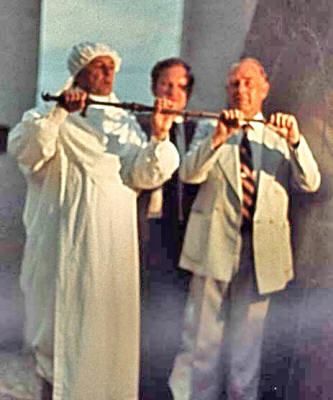
Figure 25. Druid John
Bevan pronouncing the Stonehenge open
(Dr. Senne is also
holding the sword, and Dr. Summers is in the background).
The modern Druids are a Society in
Britain who have been formed to maintain the language and customs of
Wales. They are not the religious priests who practices in England
at the time of the Roman Invasion.
As part of the dedication, Mr. Bevan used the following Welsh
invocation:
Dyro Dduw dy nawdd
Ac yn nawdd nerth
Ac yn nerth deall
Ac yn neall gwybod
Ac yng ngwybod, gwybod y cyfiawn
Ac yng ngwybod y cyfiawn, ei garu.
Ac o garu, caru pob hanfod
Ac o garu pob hanfod caru Duw
Duw a pob diani.
Which is the Archdruid's Prayer,
followed by the call for Peace:
Y gwir yn erbyn y byd
A oes heddwch ? (Response - Heddwch)
Gwaedd uwch adwaedd
A oes heddwch ? (Response - Heddwch)
Llef uwch adlef
A oes heddwch (Response - Heddwch)
Heddwch
A cheese-henge decorated the following
reception.
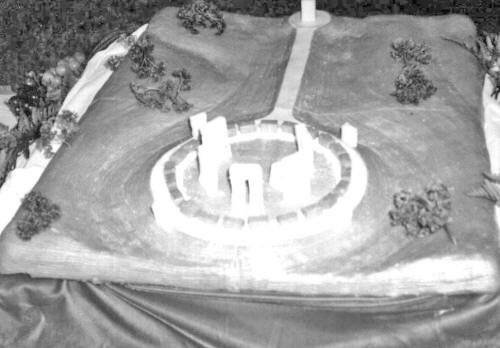
Figure 26. The UMR
Cheese-henge.
Back to Top
Do the
marks on the stone have any significance?
The dark and light marks on the stone are natural features exposed
when the stone was cut, they have no other significance.
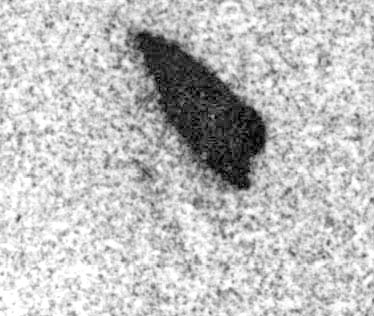
Figure 27. A natural
mica "arrowhead" exposed when the rock was cut.
Similarly, the closing of the trilithon
ring coincident with a solar eclipse at Rolla, was purely an
accidental coincidence of timing.
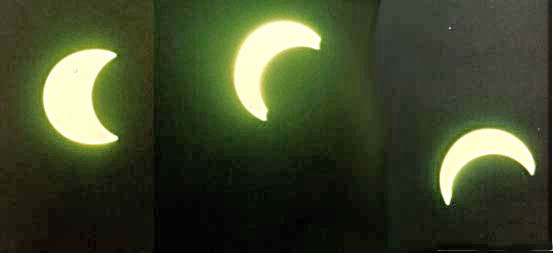
Figure 28. Stages in
the eclipse during the setting of the Trilithon ring.
Back to Top
Is the
UMR Stonehenge the only one in America?
There are several other monuments in the United States which are
somewhat similar to that erected at UMR. The nearest is the Woodhenge, which was built as part of the construction of the mounds
in Illinois, just over the river from St. Louis, several hundred
years ago. More recently, and along the lines of this monument, just
after the First World War, Sam Hill (1857-1931) a railroad tycoon
and businessman, sought to erect a monument to the 13 fallen war
dead from Klickitat County, Washington.
He chose a site on the hills overlooking
the Columbia River, about 115 miles east of Portland, Oregon. Using
the English Stonehenge as his theme, he decided to use concrete
rather than the local rock, which was considered to be of poor
quality.
The site was dedicated, following the pouring of the altar, on July
4, 1918. The site was designed to follow the original version, as
best as could be determined from scientific evidence at the time.
The monument took some eleven years to complete, and required
approximately 1650 tons of concrete.
In order to provide a surface closer to
that of the original, the frames for the concrete pillars were lined
with crumpled tin. He built his memorial out of concrete in the form
of a full scale version of the original Stonehenge.
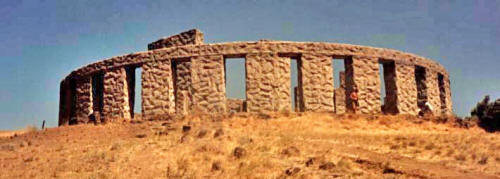
Figure 29. Concrete
Stonehenge at Maryhill, in Washington State.
The monument is not an exact replica,
because of the problems which arose with the local hills and the
presence of the river gorge. Thus, the hills block the midsummer
sunrise over the heel stone, which is considerably smaller and
closer to the circles than at the original.
Unfortunately, the concrete has also
started to weather severely, and up to two inches of erosion could
be measured on some of the stones only fifty years after the
monument was completed.
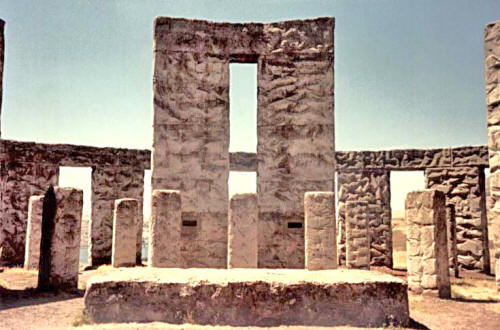
Figure 30. The altar
stones at the Maryhill Henge.
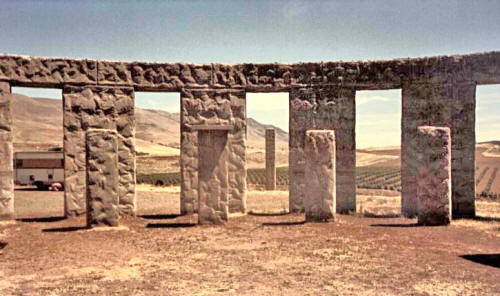
Figure 31. Looking at the Maryhill heelstone (the narrow rock behind
the ring).
More recently the Elberton Granite
Association was commissioned to build what are known as
the Guidestones. These are an assembly of rocks, which stand a total of
19 ft 3 inches high, which carry the same universal message of
peace, in eight of the most common languages of man.
These are English, Russian, Hebrew,
Arabic, Hindi, Chinese, Spanish and Swahili. In addition, the
capstone carries part of the message in Babylonian Cuneiform,
Egyptian Hieroglyphics and Classical Greek.
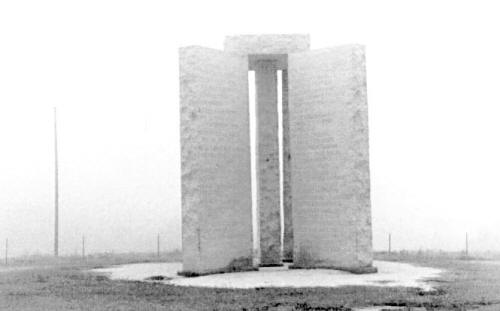
Figure 32. The
Guidestones Monument in Elberton, Georgia.
The Guidestones are located just outside
of Elberton, in Georgia. They weigh a total of 237,746 lbs, and were
carved using thermal lances rather than using waterjets. The
lettering was then carved into the stones to carry the various
messages.
The stones themselves site on slabs
which are flush with the surface, and the entire site was, when
visited, located in a pasture.
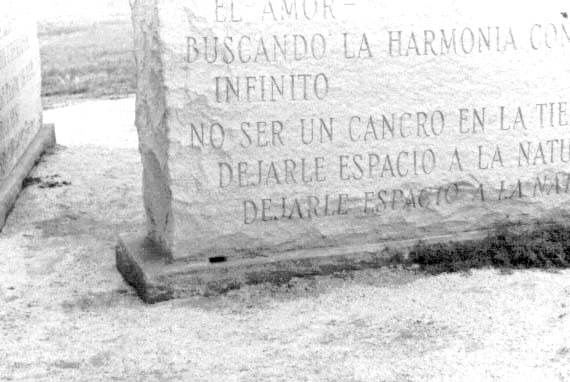
Figure 33. Detail of
a Guidestone showing the Spanish language, and the mounting.
The Gnomen, or Center Stone, has a
small
window through its center which is aligned with the Pole Star. This
alignment changes over the years, so that the star will not always
be in the center of the view. This is unlike the UMR Polar window,
which was made large enough to retain the star position for the next
4,000 years.
At an erosion rate of one inch every
thousand years, it is our hope that by that time the window will
have grown to accommodate any additional size changes required.
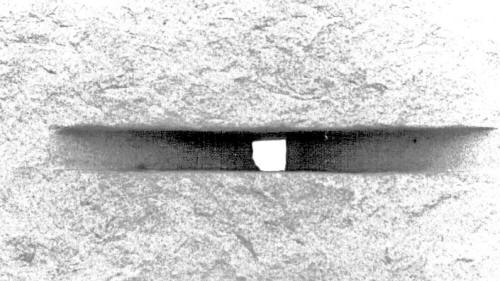
Figure 34. The
Guidestone Polar window.
In addition there have been a number of
"modern" versions of Stonehenge. For example in Whitby, Ontario
Canada, a sculptor Bill Lishman, has built a version of the megalith
using old partially crushed cars to generate the equivalent of the
stones.
The cars have been compressed to match
the size of the stones in the original Stonehenge.
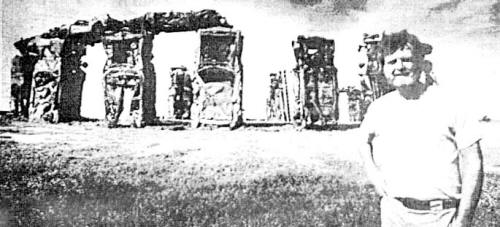
Figure 35. Bill
Lishman and his "carhenge".
Back to Top
What
will happen to this site?
The UMR-Stonehenge will be the central focus of a park where
students and visitors alike may enjoy, hopefully for millennia*, a
reminder of the abilities of our fathers - for remember the original
was twice this size - and to accept the challenge of developing new
technology for the future through this understanding of the past. It
should be remembered that the original considerably outdated the
Romans.
*If not the builders would be glad to listen to any complaints.
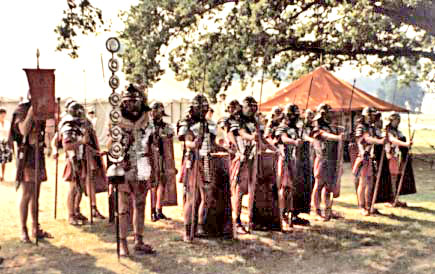
Figure 36. Modern
"Romans" parading near Hadrians Wall.
In its current form the UMR Stonehenge
is made up of an outer ring of four Pole Stones; a circle of stones,
meant in this model for seats and known as the Sarsen Stones; the
inner ring of five three-stone Trilithons and the two stones which
make up the central Analemma.
It was in this form that the University
received an award for one of the Ten Outstanding Engineering
Achievements of the National Society of Professional Engineers. That
year other awards included the Chicago Sewer System, and the
Hubble
Telescope.
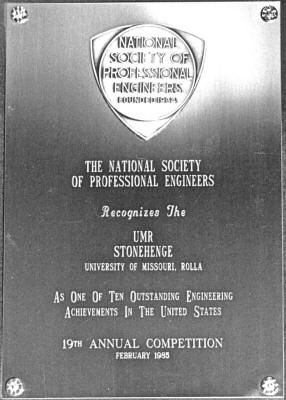
Figure 37. Plaque
awarded to UMR for this sculpture.
Over a ten year
period UMR was one of only three Universities to achieve this high
national honor.
It is hoped however that this will not
mark the end of the development of this site. For the original site
underwent several changes over the millennia of its development. One
current suggestion is to add a ring of nineteen knights, to be known
as the Knights of St. Ninian.
Two questions need to be answered here, why nineteen knights and who
was St. Ninian.
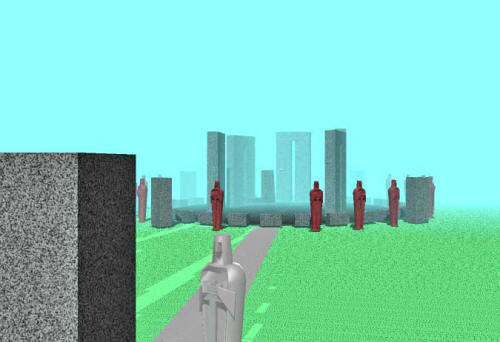
Figure 38. Conceptual
design for the addition of the Knights of St. Ninian ring.
Back to Top
Why
Nineteen Knights?
This relates to the final ring of stones which were added as our
ancestors at the original Stonehenge worked to develop a clock which
would give them a calendar. The last ring added was the Bluestone
ring and this had nineteen stones. If one multiplies nineteen by
nineteen then one gets 361. If one then adds the four feast days
when "time stands still" then this gives the number of days in a
year.
This Hyperborean calendar would therefore be marked with the
positioning of the nineteen knights of St. Ninian. The four feast
days would be replaced by the Pole stones which have already been
placed around the inner two rings of stone, and which would be
integrated into the Knight Ring. This would therefore integrate the
American and European solar clocks into the structure.
Back to Top
Who was
St. Ninian?
Many people associate St. Patrick with engineering, and at UMR this
is commemorated with St. Patrick's Day observances and a parade.
However it is appropriate to remember that many engineering
innovations were made by Scots.
And just as St. Patrick is remembered
for bringing Christianity to Ireland, St. Ninian performed the same
function for Scotland, and his memorial can be found at Whithorn
Priory in Wigtown, Scotland. On an engineering campus it is fitting
to recognize in this way the contribution that Scots have made to
engineering progress.
Back to Top
Why are
the faces blank?
It is intended that the sculptures be carved using high pressure waterjets, as an indication of the progress in the use of this
innovative tool for 3-Dimensional sculpting, beyond the linear cuts
of the surrounding stones. However UMR is internationally recognized
for a number of areas, and has many re-knowned alumni and
benefactors. By using the tools of these other departments it will
be possible to create a remembrance for each Knight to personify a
major benefactor to the University.
Since there are only 19 such knights and
the monument will stand for several thousand years it will likely
take a long time to find individuals who qualify for this honor.
(The only probable equivalent is to qualify for additional space at
Mount Rushmore).
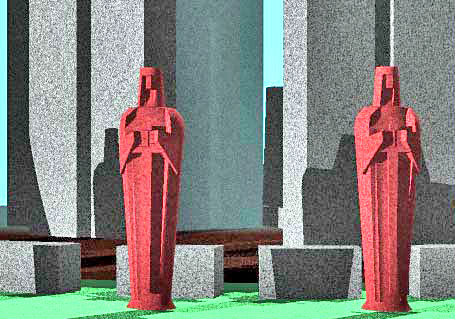
Figure 39. Current
design for the knights.
It is hoped that some design competition
be held to create a design for the knights which can be carved from
Missouri granite using waterjet technologies. If Missouri granite is
used the two granites will provide a pleasant color contrast.
Back to Top
When is
this going to happen?
As with all things this will require some financing. Hopefully a
funding source can be identified to make this addition more rapidly
than occurred in the case of the original model. Those interested in
contributing may wish to contact either Tom Webb at
c2873tew@umrvmb.umr.edu or Dave Summers at
dsummers@umr.edu. Dave will also be glad to answer those
other questions that he can about waterjet cutting and other matters
related to this sculpture.
Back to Top
Bibliography
The following books and articles may be of interest to readers:
-
Piini, Ernest W. (1980),
America's Stonehenge, Sarsen Press, Redwood City, CA, 30 p.
-
Hawkins, Gerald S. (1970),
Stonehenge Decoded, Fontana Press, 253 p.
-
Plotts, Lois D. (1981),
Stonehenge at Maryhill, private printing, 32 p.
-
Shepherd, R. (1980), Prehistoric
Mining and Allied Industries, Academic Press, 272 p.
-
Noble, David G. ed (1984), New
Light on Chaco Canyon, School of American Research Press,
95p.
-
Chippindale, Christopher (1983),
Stonehenge Complete, Thames and Hudson, 295 p.
-
Pike, Donald G. and Muench,
David (1974), Anasazi-Ancient People of the Rock, Crown
Publishers, 191 p.
-
Wood, John E. (1980), Sun, Moon
and Standing Stones, Oxford University Press, 217 p.
-
Balfour, Michael (1979),
Stonehenge and its Mysteries, Hutchinson and Co.
(Publishers) Ltd., 192 p.
Back to Top
|





















